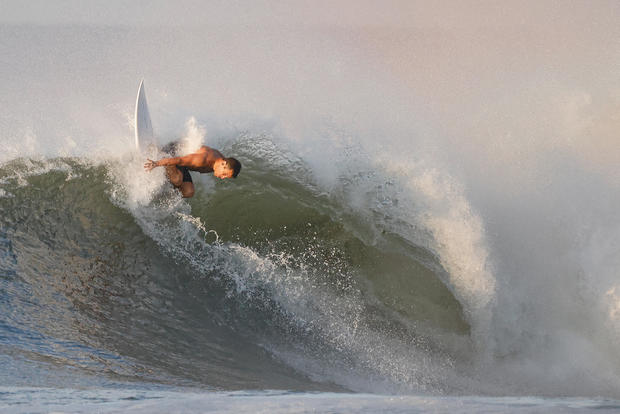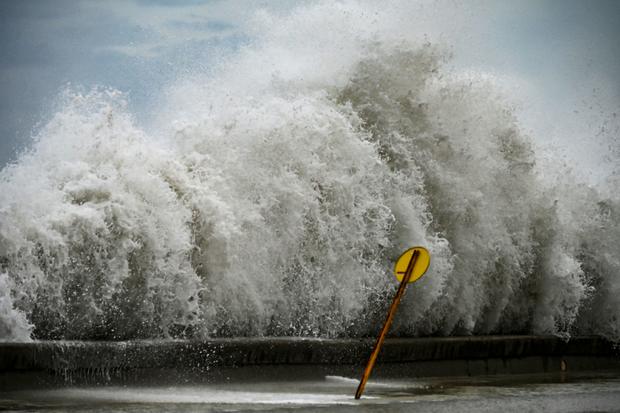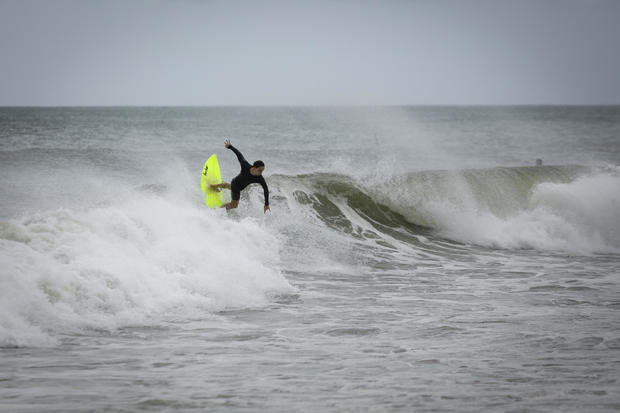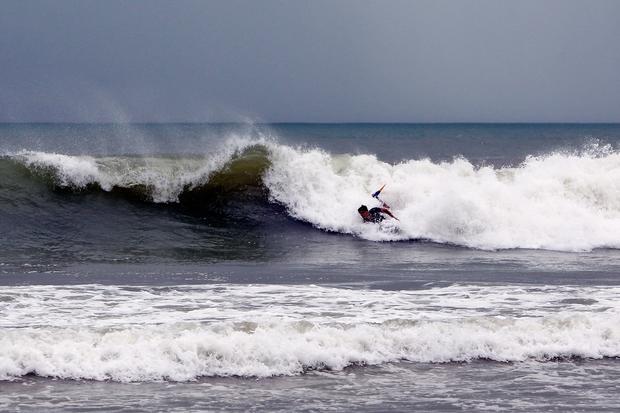"It's really dangerous": Surfers face "chaotic" waves and storm surge in hurricane season
As Hurricane Irma raged in the Caribbean at the peak of the 2017 Atlantic hurricane season, rising professional surfer Zander Venezia, a teenager, died in a sudden drowning while trying to ride mega-swell waves in Barbados. It was neither the first nor the last time a surfer's attempt to venture out during a storm surge ended in tragedy.
"It's really common when we're in September and having those hurricane conditions to have a very unexpected storm surge," said Corey Senese, a lifelong surfer who founded and gives lessons at CoreysWave, a surfing school in Montauk, New York.
"We do have a few terrible, tragic stories involving storm surges," Senese told CBS News. "It's really dangerous because you're not expecting it."
Senese noted that surfers, swimmers and beachgoers alike contend with potentially perilous circumstances year-round, like sneaker waves, rogue waves, undertow and rip currents, which can be deadly.
As Hurricane Lee churned towards New England in mid-September, some surfers on Long Island jumped at the chance to ride 10-foot waves, even as the National Hurricane Center warned that swells from the storm were "likely to cause life-threatening surf and rip current conditions" as well as storm surges.
Storm surges — abnormal rises in water levels generated by storms — can be seen any time of year but are mainly linked to hurricanes and other strong tropical storm systems. They can pose serious threats during hurricane season, which began on June 1 and lasts until Nov. 30.
What is a storm surge? What causes it?
The National Oceanic and Atmospheric Administration predicted in May that the 2023 hurricane season would be "near normal," but in early July, scientists from Colorado State University said their forecast now calls for "an above-average" season. They said the outlook is more uncertain than normal because of unusually warm sea surface temperatures in portions of the Atlantic Ocean and the arrival of an El Niño.
Hurricanes produce powerful winds — in a Category 5, reaching 157 miles per hour or more. And while those winds can be devastating, scientists say the greatest threat to life in a hurricane is posed by storm surge, which is an abnormal rise in water levels caused by hurricane-force winds pushing that water toward shore and over areas of land that are normally dry.
As a surge advances and combines with normal, astronomical tides, a 15-foot surge occurring on top of a high tide that is already 2 feet above average sea level would produce a 17-foot storm tide. In the worst instances, water levels can rise 30 feet or more, according to NOAA, as it did with Hurricane Katrina, a Category 3 storm that caused catastrophic damage when it made landfall in New Orleans in 2005.
More intense hurricanes produce higher storm surges, according to the National Hurricane Center, which cites a storm's maximum wind speeds and the size of the storm as two important factors in determining the extent of a surge. Larger hurricanes and stronger winds correlate with greater storm surges, although surges can also be influenced by other factors like atmospheric pressure, the shape of the coastline as well as the ocean floor, and the angle at which a hurricane approaches coastal land.
- Here's what the hurricane categories mean
- The 2023 Atlantic hurricane season begins June 1. Here's what experts say to expect.
- Hurricanes and climate change: What's the connection?
The geography in certain places — along the Gulf Coast in the United States, for example — lends itself to particularly severe storm surges, and that sensitivity means less force is required on the part of the hurricane to trigger a higher surge.
"You can take the same hurricane, with respect to how big it is and how strong it is, and if you allow it to make landfall on different parts of the coastline within the United States, you might get a different result with respect to how high the water is in any given area," Cody Fritz, a storm surge specialist and team lead of the Storm Surge Unit at the National Hurricane Center, told CBS News.
Why are storm surges so dangerous?
A storm surge can inundate surrounding regions with water, threatening beaches, coastal highways, boats and buildings. If there are smaller bodies of water nearby, like lakes or rivers, storm surge can exacerbate flood risks in those areas, too, as it moves inland.
"Storm surges are brutal and can bring down a town or fishing village in less than a minute," said Luís Madureira Pinto, founder and manager of the website SurferToday.com, who has been surfing for roughly three decades.
Pinto is based in Porto, a coastal city in northwest Portugal where surfing is popular, and which has in recent years weathered several destructive storm surges that brought excessive flooding.
"The problem with storm surges is that these waves tend to be chaotic and do not have a regular breaking pattern. They break here and there, they're bigger and smaller," he said, adding that a storm surge "can change the quality of the wave dramatically."
"When it comes to surfing, there is only one wise option — do not paddle out," Pinto told CBS News in an email. "It's dangerous and totally useless."
Storm surges are dangerous for a number of reasons. Just six inches of fast-moving flood water can knock over an adult during a surge, creating a serious threat of drowning, according to the National Hurricane Center. Two feet of rushing water is enough to sweep away vehicles of almost any size.
Surges can also happen at seemingly random intervals before, during or after a storm, and can cause water levels to rise substantially in minutes, so heeding evacuation notices and other safety protocols ahead of time is important and could be life-saving.
Be aware of warnings and risks
While storm surges cannot be prevented, weather experts have systems in place to track them, allowing communities in the expected path of a hurricane to prepare.
To evaluate the risk of a storm surge, forecasters use a computer modeling system called Sea, Lake and Overland Surges from Hurricanes, or SLOSH, which was developed by the National Weather Service. It can estimate surge heights based on water depths, land elevation and barriers to the flow of water in an area where a storm is headed. Accuracy depends on how closely forecasters can approximate key properties of the hurricane itself, including its trajectory, intensity and size.
Predictions that emerge from the modeling system help inform the alerts, recommendations and public safety protocols during weather emergencies, like evacuations. Fritz, with the National Hurricane Center, underscored the value of those warnings.
"I wouldn't advise being out in the areas where a storm is approaching," he said. "When a storm surge comes in it can be very fast and destructive. It's not something that any one person should kind of mess with. I mean, there's a reason why we put out warnings to alert the public about the dangers of storm surge, because it is life threatening, ultimately."
For athletes like Senese, who, at 41, has now been surfing at beaches across the country for about 35 years, staying safe in the water, particularly during hurricane season, means monitoring daily weather forecasts and observing wave patterns in real time.
"Any surfer on the beach is always going to have just slightly more awareness of the waves just because of the problem that surfers have where they never stop thinking about waves. So usually you end up seeing it," Senese said.
"Surfers have a bunch of different resources we use to check the surf, but you can always look at the wave size and have a good idea whether it's safe," he said.
Reconciling safety with the thrill of riding more dramatic waves can boil down to a surfer's experience and comfort levels, said Senese, who emphasized the importance of finding a personal "threshold" and — his principal piece of advice — resisting the impulse to panic no matter the conditions.
"When a hurricane slams our coast, it's important to be aware of all the dangers," says the narrator in "Making Waves," an audio and visual podcast from NOAA's National Ocean Service, during an episode focused on storm surge. "Don't take unnecessary risks during a storm. Conditions can change in the blink of an eye."






